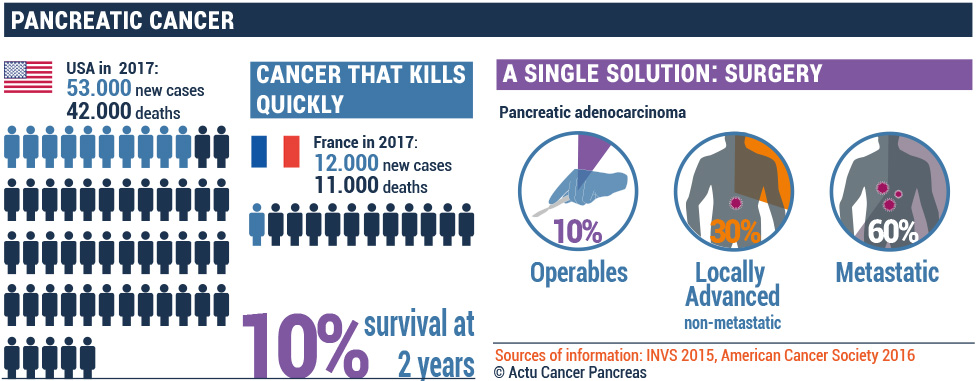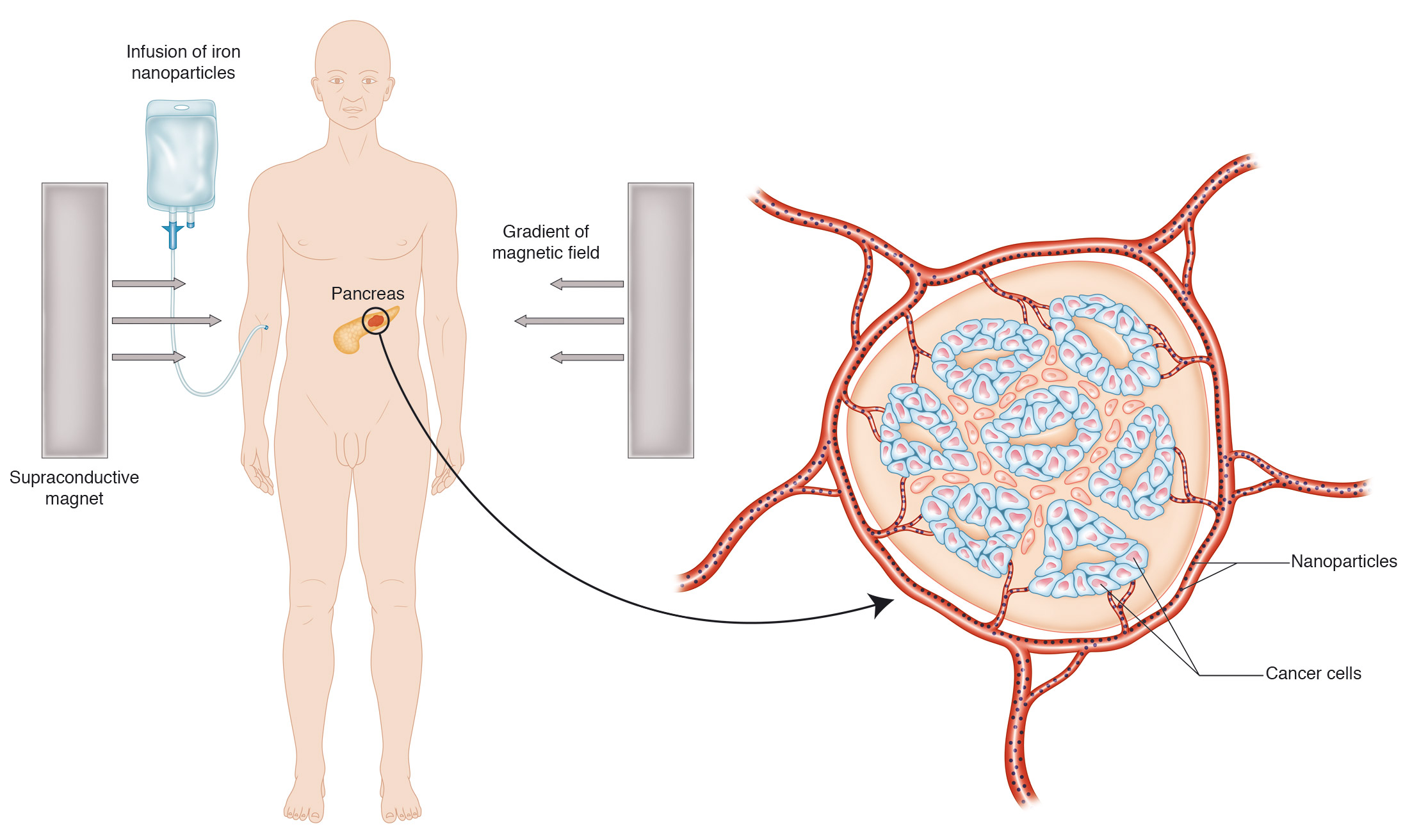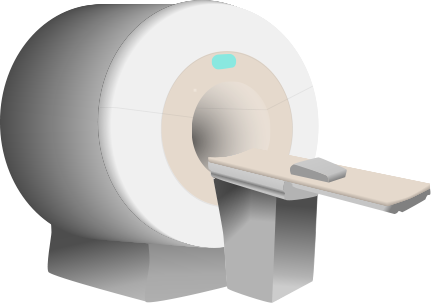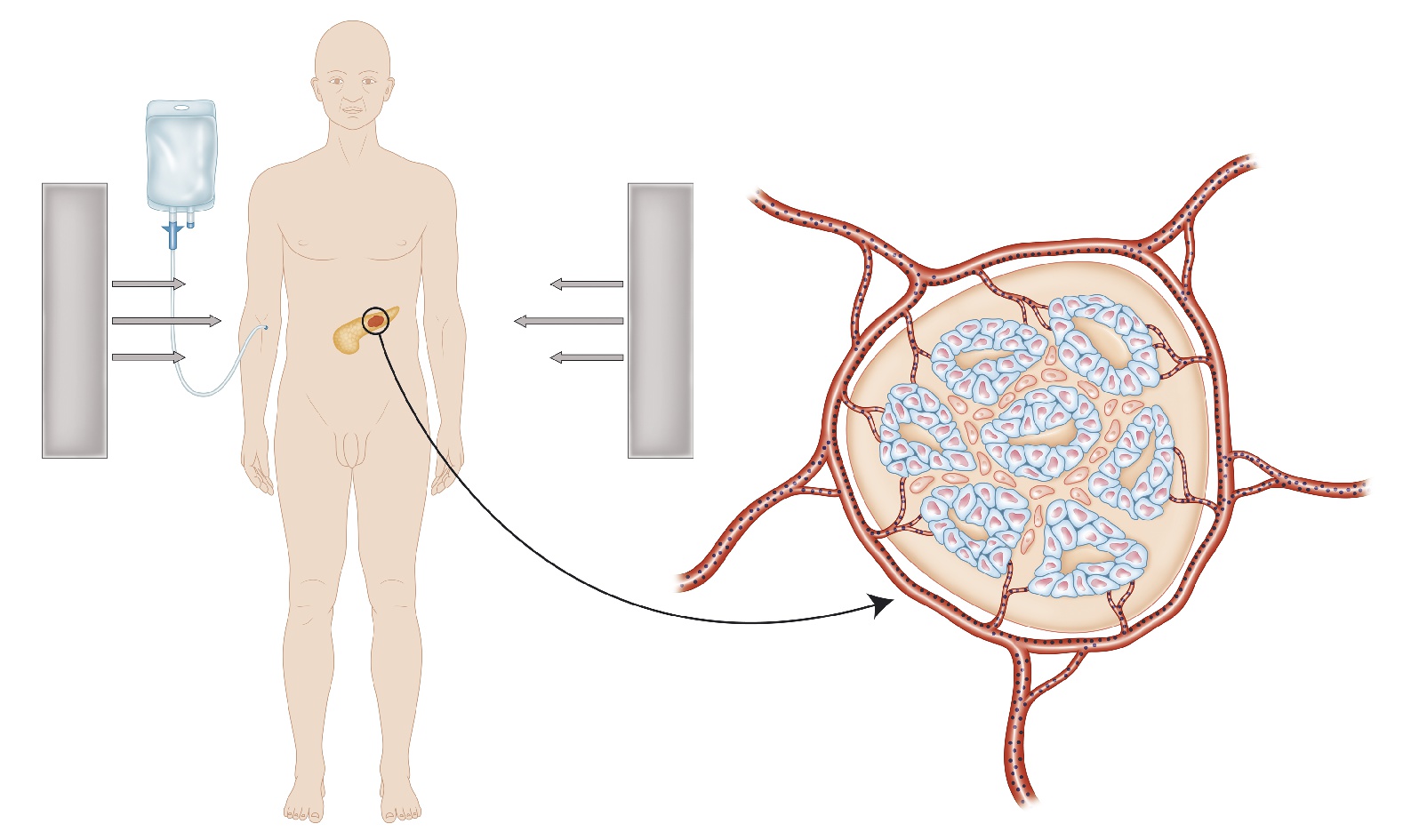Why CC&C tackles pancreatic cancer
Tackle “unmet needs”
Our technology can be applied to all solid cancers. But some cancers are now properly cared for when others are particularly lethal, like cancer of the pancreas: In the US in 2016, 52,000 new cases and 42,000 deaths.
Facilitate the use of surgery
Today, surgery is rarely possible, in less than 10% of the patients. Moreover, this pathology is constantly increasing, and if nothing is done, it will be the second cause of cancer mortality in 2030. It is therefore urgent to propose solutions to these patients.
Our method applies to non-metastatic non-operable tumors, which represents 4,000 patients per year in France, 16,000 in the USA, and 140.000 in the world.
In the medium term, we plan to apply our method to other “unmet needs” tumors such as glioblastoma, or liver cancer that is very common in Asia.
Physical Oncology
A brief panorama, in video, of the progress of the discipline
Consult our scientific Bibliography on the subject.
“In oncology, tissular phenotype is dominant towards cellular genotype”
Direct action on the cellular tissue
Our method can be described as follows: magnetic particles are incorporated into the neoangiogenesis network surrounding the tumor. A magnetic field gradient is imposed on the whole tumor and neovessels containing the particles. Nanoparticles act as « bioactuators», transforming magnetic energy into mechanical energy. The nanoparticles impose a stress field on the tumor.
A short- and medium-term strategy
As a first step, we aim to reduce the volume of tumors, to make them operable and, secondly, to prove that the normal tissue architecture can be re-established and the cancer process reversed.
Focus on the two technologies at stake
Superconducting magnets
Electromagnetic field technology, electrotechnology, is a field of engineering science mastered for a long time, and used in many fields such as energy production and transport, telecommunications, medical imaging. The proposed device is close to an MRI in design, volume, and cost of production. Intensive magnetic fields have already been used in many Nuclear Magnetic Resonance (NMR) patients since the 1960s.
The change of scale from rodent to human, that is to say from a few centimeters to a few tens of centimeters, will require the use of superconducting magnets. This technology is widely used and deployed particularly in Medical Imaging, with MRI. The processing of the mouse experiment data will greatly accelerate the modeling of the human prototype.
Ferric nanoparticles
We use ferric nanoparticles vectorized to the activated endothelial cells of the tumor neovasculature. Particles of this type are available for injection in animals, as a MRI contrast medium. Their toxicity is thus a priori known and minimal.
Frequently Asked Questions
To fully understand our technology, we must not fall into the following traps:


| It is not a magnetic action on the tumor | It's a set of forces/pressure (a field) exerted on the tumor | |
| It is not a system for heating nanoparticles | It's an use of nanoparticles to transform magnetic energy into mechanical energy in contact with the tumor | |
| It is not the improvement of an already existing method | It's indeed a disruptive innovation, a paradigm shift, as immunotherapy was a few years ago | |
| This is not an action on the genome of each of the cancer cells | It's an action on the environment of the cancerous tissue | |
| It is not a method of destroying all cancer cells up to the last | It's a means of controlling tumor growth, or even reversing it for a return to normal tissue architecture and function | |
| It's not a molecule, it's not a drug | It's a combination of two medical devices | |
| It's not biology or chemistry | It's physics |
Our latest scientific news
Our scientific publications
Our Proof of Concept : Mechanical Signals Inhibit Growth of a Grafted Tumor In Vivo: Proof of Concept (PlosOne 2016)
Communication at the American Association for Cancer Research (2017)
Presentation poster of our Innovation (2016)
Rémy Brossel’s book
Forces & Cancer – From Biology to Physics, from the Laboratory to the Patient
42 pages, free download
Scientific Bibliography in Physical Oncology
For beginners
The basic principles: : Ted Talks by Mina Bissel (2012)
The Wikipedia article on “Physical Oncology
(we wrote it…)
A good introductory article by Erika Jonietz in Nature (for a fee)
A fairly comprehensive presentation on the relationship between Physical Sciences and Oncology on the AACR site
Literature
The link between the ECM and the nucleus
Wang N, Tytell JD, & Ingber DE
Mechanotransduction at a distance: mechanically coupling the extracellular matrix with the nucleus.
Nature Reviews Molecular Cell Biology volume 10, 75–82 (2009)
In Vitro
Matthew J Paszek, Nastaran Zahir, Kandice R Johnson et al.
Tensional homeostasis and the malignant phenotype
Cancer Cell 2005, 8; 241-254
Montel F, et al.
Stress clamp experiments on multicellular tumor spheroids.
Phys Rev Lett 107(18): 188102. (2011)
G Cheng et al.
Micro-Environnental Mechanical Stress Controls Tumor Spheroid Size and Morphology by Suppressing Proliferation and Inducing Apoptosis in Cancer Cells.
PloS One 4(2) (2009)
Ex Vivo
Plodinec M, et al.
The nanomechanical signature of breast cancer.
Nat Nanotechnol 7(11): 757-765. (2012)
Thermodynamics
EJ Mah, AF Yee, MA Digman
Metabolism Modulation of Cancer Cells on Varying Substrate Stiffnesses
Biophysical Journal, 2018
Reversion
Benjamin L Ricca et al
Transient external force induces phenotypic reversion of malignant epithelial structures via nitric oxide signaling
eLife, 2018
Interactions with genetics
J Werfel et al.
How Changes in Extracellullar Matrix Mechanics and Gene Expression Variability Might Combine to Drive Cancer Progression.
Plos One 8 (10) e76122 (2013)
Synergy with Immunotherapy
Ayako Miyazawa et al.
Regulation of PD-L1 expression by matrix stiffness in lung cancer cells
Biochemical and biophysical research communications 495.3 (2018): 2344-2349.
Why CC&C tackles pancreatic cancer
Tackle “unmet needs”
Our technology can be applied to all solid cancers. But some cancers are now properly cared for when others are particularly lethal, like cancer of the pancreas : in the US in 2016, 52,000 new cases and 42,000 deaths.
Facilitate the use of surgery
Today, surgery is rarely possible, in less than 10% of the patients. Moreover, this pathology is constantly increasing, and if nothing is done, it will be the second cause of cancer mortality in 2030. It is therefore urgent to propose solutions to these patients.
Our method applies to non-metastatic non-operable tumors, which represents 4,000 patients per year in France, 16,000 in the USA and 140.000 in the world.
In the medium term, we plan to apply our method to other “unmet needs” tumors such as glioblastoma, or liver cancer that is very common in Asia.
Physical Oncology
A brief panorama, in video, of the progress of the discipline
Consult our scientific Bibliography on the subject.
“In oncology, tissular phenotype is dominant towards cellular genotype.”
Direct action on the cellular tissue
Our method can be described as follows: magnetic particles are incorporated into the neoangiogenesis network surrounding the tumor. A magnetic field gradient is imposed on the whole tumor and neovessels containing the particles. Nanoparticles act as «bioactuators», transforming magnetic energy into mechanical energy. The nanoparticles impose a stress field on the tumor.
A short- and medium-term strategy
As a first step, we aim to reduce the volume of tumors, to make them operable and, secondly, to prove that the normal tissue architecture can be re-established and the cancer process reversed.
Focus on the two technologies at stake
Superconducting magnets
Electromagnetic field technology, electrotechnology, is a field of engineering science mastered for a long time, and used in many fields such as energy production and transport, telecommunications, medical imaging. The proposed device is close to an MRI in design, volume, and cost of production. Intensive magnetic fields have already been used in many Nuclear Magnetic Resonance (NMR) patients since the 1960s.
The change of scale from rodent to human, that is to say from a few centimeters to a few tens of centimeters, will require the use of superconducting magnets. This technology is widely used and deployed particularly in Medical Imaging, with MRI. The processing of the mouse experiment data will greatly accelerate the modeling of the human prototype.
Ferric nanoparticles
We use ferric nanoparticles vectorized to the activated endothelial cells of the tumor neovasculature. Particles of this type are available for injection in animals. They were also used ias a MRI contrast medium. Their toxicity is thus a priori known and minimal.
Frequently Asked Questions
To fully understand our technology, we must not fall into the following traps:

It is not a magnetic action on the tumor
It is not a system for heating nanoparticles
It is not the improvement of an already existing method
This is not an action on the genome of each of the cancer cells
It is not a method of destroying all cancer cells up to the last
It’s not a molecule, it’s not a drug
It’s not biology or chemistry

It’s a set of forces/pressure (a field) exerted on the tumor
It’s an use of nanoparticles to transform magnetic energy into mechanical energy in contact with the tumor
It’s indeed a disruptive innovation, a paradigm shift, as immunotherapy was a few years ago
it’s an action on the environment of the cancerous tissue
It’s a means of controlling tumor growth, or even reversing it for a return to normal tissue architecture and function
It’s a combination of two medical devices
It’s physics
Our Proof of Concept : Mechanical Signals Inhibit Growth of a Grafted Tumor In Vivo: Proof of Concept (PlosOne 2016)
Communication at the American Association for Cancer Research (2017)
Presentation poster of our Innovation (2016)
Rémy Brossel’s book
Forces & Cancer – From Biology to Physics, from the Laboratory to the Patient
42 pages, free download
Scientific Bibliography in Physical Oncology
For beginners
The basic principles: : Ted Talks by Mina Bissel (2012)
The Wikipedia article on “Physical Oncology
(we wrote it…)
A good introductory article by Erika Jonietz in Nature (for a fee)
A fairly comprehensive presentation on the relationship between Physical Sciences and Oncology on the AACR site
Literature
The link between the ECM and the nucleus
Wang N, Tytell JD, & Ingber DE
Mechanotransduction at a distance: mechanically coupling the extracellular matrix with the nucleus.
Nature Reviews Molecular Cell Biology volume 10, 75–82 (2009)
In Vitro
Matthew J Paszek, Nastaran Zahir, Kandice R Johnson et al.
Tensional homeostasis and the malignant phenotype
Cancer Cell 2005, 8; 241-254
Montel F, et al.
Stress clamp experiments on multicellular tumor spheroids.
Phys Rev Lett 107(18): 188102. (2011)
G Cheng et al.
Micro-Environnental Mechanical Stress Controls Tumor Spheroid Size and Morphology by Suppressing Proliferation and Inducing Apoptosis in Cancer Cells.
PloS One 4(2) (2009)
Ex Vivo
Plodinec M, et al.
The nanomechanical signature of breast cancer.
Nat Nanotechnol 7(11): 757-765. (2012)
Thermodynamics
EJ Mah, AF Yee, MA Digman
Metabolism Modulation of Cancer Cells on Varying Substrate Stiffnesses
Biophysical Journal, 2018
Reversion
Benjamin L Ricca et al
Transient external force induces phenotypic reversion of malignant epithelial structures via nitric oxide signaling
eLife, 2018
Interactions with genetics
J Werfel et al.
How Changes in Extracellullar Matrix Mechanics and Gene Expression Variability Might Combine to Drive Cancer Progression.
Plos One 8 (10) e76122 (2013)
Synergy with Immunotherapy
Ayako Miyazawa et al.
Regulation of PD-L1 expression by matrix stiffness in lung cancer cells
Biochemical and biophysical research communications 495.3 (2018): 2344-2349.











